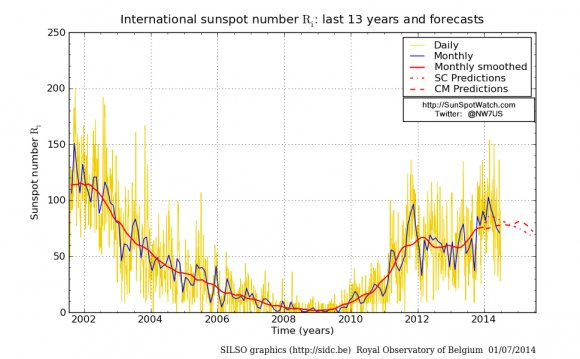
Solar activity can aid or hamper HF propagation beyond line-of-sight range. Many information sources can help us keep up with solar conditions. This month, ARRL Laboratory Technician Mike Gruber, WA1SVF, assisted by Senior Technical Editor Dean Straw, N6BV, answers some questions about how Ol' Sol influences the propagation of radio signals.
I've only been on the air on HF for a year. I've heard about the Sun's 11-year sunspot cycle and would like some details. Can you help?
I'd be delighted. First, let me state that the interactions between the Sun and our Earth are incredibly complex. Even scientists who have studied the subject for years do not completely understand everything that happens on the Sun. I will try to give you some general background about how the Sun affects radio propagation here on Earth.
The Sun emits electromagnetic radiation of all kinds, ranging in frequency from below HF all the way to the X-ray region. Much of the energy is emitted as heat. Some solar radiation ends up here on Earth, providing the energy needed to sustain all activity here-including HF radio propagation. Although our Sun is not a particularly large or spectacular star, it still radiates an almost unimaginable amount of energy into space. The total power radiated by the Sun is estimated at 4´1023 kW-that is, the number four followed by 23 zeroes. At its surface, the Sun creates about 60 megawatts per square meter. Now that is some transmitter!
The Sun also is constantly ejecting material from its surface in all directions into space. This makes up the so-called solar wind. Under relatively quiet solar conditions the solar wind blows around 200 miles per second-675, 000 miles per hour-taking away about two million tons of solar material each second from the Sun. Don't worry: the Sun is not going to shrivel up anytime soon. It's big enough that it will take many billions of years before that happens.
A 675, 000-mph wind sounds like a pretty stiff breeze, doesn't it? Lucky for us, the density of the material in the solar wind is very tiny by the time it has been spread out into interplanetary space. Scientists calculate that the density of the particles in the solar wind is less than that of the best vacuum they've ever achieved on Earth. However, even such a low density of solar particles can have immense effects here on Earth.
For years scientists have used different filters on their optical telescopes to observe various aspects of solar activity. Starting in the 1930s, observations began at radio frequencies and now we have satellites that specialize in watching what happens at the Sun and in space.
One of the best known gauges of overall solar activity is the number of sunspots seen on the Sun's surface. Sunspots are relatively cool areas that appear as dark spots. (CAUTION: Do not look at the Sun with the naked eye or a telescope; you could permanently damage your eyes.) Surprisingly, sunspots are not really dark, but appear so only because the surrounding surface is even hotter and brighter. A large sunspot can be up to 80, 000 miles in diameter.
Systematic study of solar activity began around 1750. Long-term sunspot activity varies in cycles. On average, the number of sunspots reaches a maximum every 11 years, but the period has varied from 7 to 17 years. The first cycle to be completely and scientifically observed began in 1755; we know it as Cycle 1. We are now just starting Cycle 23. Solar activity also follows a 27-day cycle: the sun's rotational period.
Sunspot activity changes continuously. A sunspot can vary in size and appearance, or even vanish, within a single day. Large areas of sunspot activity usually last through several rotations of the Sun, some as long as two years. To offset the confusing effects of short-term changes, we average (or smooth) solar data. HF propagation predictions commonly use Smoothed Sunspot Numbers (SSN), which are monthly sunspot counts averaged over a 12-month period.
Solar-flux readings are another measure of solar activity. The average intensity of solar emissions also varies slowly over the 11-year solar cycle. A solar flux reading is a measure of power received, per unit area, per unit frequency. The Dominion Radio Astrophysical Observatory in Penticton, British Columbia, measures 2800-MHz (10.7-cm) solar-flux data daily at local noon. Solar flux correlates well with the intensity of ionizing UV and X-ray radiation. Smoothed Sunspot Numbers range from 0 to over 200 and solar-flux numbers range from 60 to 300.
INTERESTING VIDEO












